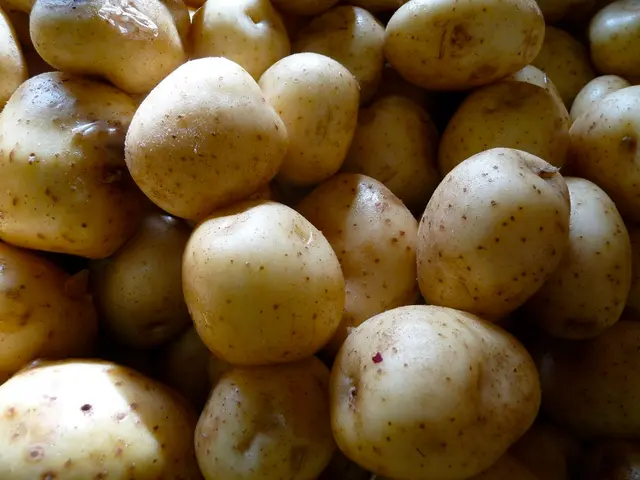Innovative Techniques for Maximizing Green Space in Miniature Gardens: A Comprehensive Guide (24 Strategies Included)
Small Garden Magic: Squeeze More Green into Less Space
Small gardens can burst with beauty, but making the most of limited territory calls for some smart thinking and a dash of creativity. Are you working with a postage-stamp yard, a pint-sized patio, or just a sliver of balcony space? Fear not! This treasure trove of tips offers 24 practical ways to swell the size of your garden. Even the tiniest plot can look lush and labor-intensive with a sprinkle of planning and the perfect tools. Let's get started!
Get Vertical
- Trellises and Arches: Add some height to your garden, while saving ground space, by supporting climbing veggies and flowering vines on trellises or arches. Tailor the material to match your garden aesthetic, like metal for a modern vibe or wood for a rustic feel. (Important: Ensure secure anchoring for stormy days.)
- Hanging Baskets: Transform the skies above your garden into verdant displays of petunias, strawberries, or compact herbs. Position hanging baskets on hooks, beams, or sturdy branches for eye-catching plants at various heights. Water them frequently as containers dry out faster in the air. Go for trailing, cascading plants for a full, picturesque effect.
- Stacked Planters: Save ground space by stacking planters along walls or fences. Whether you buy pre-made sections or fashion your own from shelves or tiered pots, this setup allows multiple plants to thrive in a tight footprint. Suitable choices include herbs, succulents, and small leafy greens. Place the tallest boxes at the base for stability and easier watering.
- Living Walls: Convert blank walls into vibrant living artwork with a vertical garden system. Ideal for herbs, ferns, or annual flowers, living walls require care, as plants share a common potting medium. Go for systems with built-in irrigation or utilize felt pockets and separate planters.
- Dwarf Plants: Select compact versions of popular plants like patio tomatoes, mini roses, or dwarf evergreens. These pint-sized wonders fit nicely into pots, raised beds, or small patches of soil, maximizing your garden's potential while reducing the need for regular pruning.
Harness the Power of Height
- Multi-tiered Plant Stands: Add a dash of depth to your garden with tiered plant stands. These stands display a variety of plants, from herbs on top to trailing vines at the bottom, in a space-saving setup that's easy to tend.
- Window Boxes and Rail Planters: Turn unused window sills, railings, or porch edges into thriving planters for herbs, lettuce, or colorful flowers. Use lightweight potting mix and shallow-root plants for optimal success. Drainage is crucial, so ensure your garden boxes provide it.
- Raised Beds: Forget battling poor soil and drainage challenges - build yourself raised garden beds! Dense planting (like square-foot gardening or cluster planting) maximizes your harvest by reducing gaps between plants, shading the soil, and keeping weeds in check.
Hang Plants by the Cliffside
- Fence Lines: Don't ignore unused fence space! Mount small planters, pockets, or narrow shelves directly to the fence for herbs, salad greens, or flowers that don't require deep soil. Aim for fence sections receiving plenty of sunlight.
- Wall Shelves: Extend your growing area by creating outdoor shelving on walls or fences. Ideal choices include herbs, succulents, or small flowering plants, and staggering the shelving layout helps maintain ideal light exposure for all plants. Don't forget to anchor them firmly.
- Steps and Ladders: Give agricultural bravura to your steps or ladders by turning them into plant holders. Opt for lightweight pots, and be cautious with watering to avoid spills. Group similar plants together for streamlined care.
Innovative Mashups
- Ornamentals and Edibles: Combine the beauty of flowers with the utility of herbs or vegetables in a single container. Tomatoes partner well with marigolds, basil with tomatoes, and petunias with lettuce - all while catching the eyes (and noses) of hungry pollinators and pest-defending insects.
- Visual Cohesion: Use repetition to maintain order and give your compact garden a cohesive feel. Repeat the same plant species, planter style, or flower color, which helps tie the space together and makes it appear more spacious.
- Train Vines Up Poles or Cages: Promote healthy, vertical growth of veggies like tomatoes, beans, or flowering vines by training them up poles or cages. This arrangement promotes airflow, reducing disease risk and saving more space on the ground.
- Tree Stumps and Pedestals: Elevate your tiresome tree stumps or pedestals by transforming them into tiers for potted plants. Choose striking-but-suitable plants, like trailing flowers, succulents, or small herbs. This is a fantastic, natural, and rustic way to add depth and beauty to your garden.
- Groundcovers: Keep weeds at bay and conserve soil moisture by planting groundcovers beneath taller plants. Choose plants like thyme, creeping Jenny, or sweet alyssum, which shield the soil and provide continuous color.
Maximize those Corners
- Corner Plant Stands: Turn neglected corners into flourishing plant kingdoms with corner-specific planters. Depending on the design, these stands can accommodate herbs, flowers, or houseplants. Opt for lightweight containers for stability.
- Overhead Hooks: Install hooks overhead to add hanging plants without crowding your floor or shelves. Hang baskets of ferns, trailing vines, or herbs, making sure the hooks are sturdy enough to handle the weight.
- Narrow Raised Troughs: Ditch the row configuration and implement narrow raised troughs along walkways or walls. Perfect for lettuce, herbs, and compact flowers, these troughs help optimize every inch of your small garden.
- Grow Bags: Use flexible grow bags to fill in nooks, crannies, and corners in your small garden. Plant root crops, tomatoes, or herbs in breathable fabric bags for easy watering and relocation. Fold and store them when not in use for space-saving benefits.
Strategic Planting
- Companion Planting: Boost your yield by selecting plants that complement each other in terms of growth, pest control, and disease resistance. For example, pair basil with tomatoes or marigolds with cucumbers.
- Hanging Planters on Deck Railings: Transform your deck or balcony railings into vertical gardens with specially designed planters. These innovative planters cling safely to railings, providing ample space for compact flowers, trailing vines, or herbs.
- Repurposed Household Items: Get creative with items you already own – turn old buckets, wooden barrels, or sinks into quirky planters. Fill them with herbs, succulents, or small flowers, and stack or hang them to form a vertical garden.
- Espalier Techniques: Train trees to grow flat against walls, saving valuable ground space, with espalier techniques. Practice this skill with apple, pear, or plum trees for a sleek, formal look. Be prepared to commit time and care to shaping and training your trees.
Small Spaces, Big Yields
Transforming even the tiniest garden into a space bursting with colors, textures, and an abundance of fresh produce is within your reach! With some innovative strategies, like vertical gardening, creative container options, and companion planting, you can unlock your small garden’s potential. Let your creativity flourish, and watch your tiny space become a rich ecosystem that brings you joy all year long!
- Incorporate a mixture of home-and-garden elements into your small garden by combining living walls, trellises, and hanging baskets, creating an attractive and productive home-and-garden lifestyle oasis.
- Make your lifestyle more sustainable by embracing home-and-garden hacks such as utilizing raised beds, planter stacks, and groundcovers to grow an abundance of herbs and vegetables, enhancing both the aesthetic appeal and functionality of your small garden.








